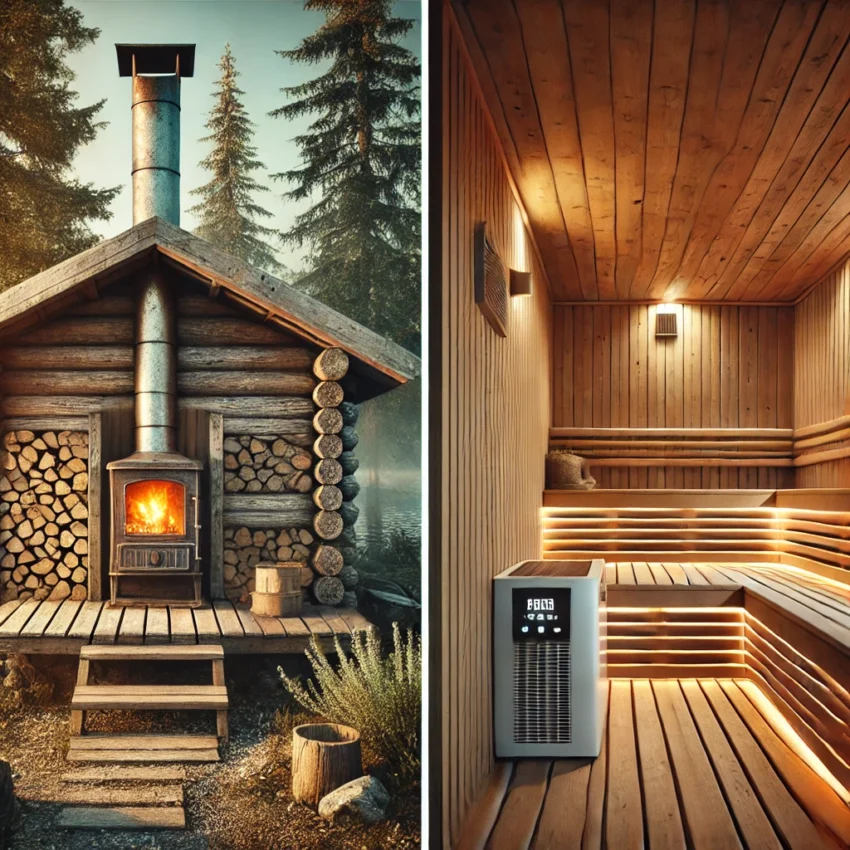Traditional saunas offer a time-tested way to enhance health and well-being—but when choosing between a wood-burning and an electric sauna heater, homeowners face a critical decision. While both honor the traditional sauna style, they differ significantly in installation, operation, experience, and maintenance.
This comprehensive guide compares wood-burning vs. electric traditional saunas, helping you choose the best option for your space, lifestyle, and wellness goals.
Overview of Traditional Sauna Heating Methods
Both electric and wood-burning heaters are designed for high-temperature, low-humidity sauna bathing, typically between 160°F to 200°F (70–100°C). However, the source and quality of heat vary by heater type.
| Feature | Wood-Burning Stove | Electric Heater |
|---|---|---|
| Heat Source | Firewood | Electric coil, 240V circuit |
| Steam (Löyly) | Yes (with water on stones) | Yes (with water on stones) |
| Ideal Use | Outdoor or off-grid | Indoor or residential |
| Temperature Control | Manual (via airflow/fire) | Digital or dial thermostat |
| Authenticity | Highest | High, but more modernized |
Wood-Burning Saunas: Authenticity and Atmosphere
How They Work:
Wood-burning stoves heat sauna stones through a combustion chamber. Airflow and fire intensity control the heat. Water poured on the stones creates löyly, the signature steam of traditional sauna culture.
Advantages:
- Authentic experience—crackling fire, scent of wood, and ritual of lighting
- Ideal for off-grid or outdoor use
- No electricity required
- Creates a softer, more immersive heat
- Excellent for larger or free-standing saunas
Disadvantages:
- Requires firewood storage and manual operation
- Longer warm-up time (30–60 minutes)
- Needs chimney or flue system
- Regulated in some areas due to smoke emissions
- Harder to install indoors
Best For:
- Sauna traditionalists seeking cultural authenticity
- Rural or outdoor setups
- Environments where firewood is easily available
Electric Saunas: Convenience and Control
How They Work:
Electric sauna heaters use heating coils beneath sauna stones. A thermostat regulates temperature, and water can still be added to the stones for steam.
Advantages:
- Fast heat-up time (20–30 minutes)
- Precise temperature control via digital panels
- Simple to operate—set and forget
- Easier to install in indoor spaces
- Requires less maintenance and cleanup
Disadvantages:
- Requires 240V electrical hookup by a licensed electrician
- Higher ongoing electricity cost than wood (depending on usage)
- Lacks natural ambiance (no fire or scent of wood)
- Not ideal for off-grid or remote locations
Best For:
- Indoor installations
- Urban/suburban homes
- Users prioritizing ease and reliability
Heat Quality Comparison
| Aspect | Wood-Burning | Electric |
|---|---|---|
| Warm-up Duration | 45–60 minutes | 20–30 minutes |
| Heat Character | Soft, radiant, moisture-rich | Dry and consistent |
| Steam (Löyly) | Full-bodied, slow-release | Fast-evaporating but controllable |
| Heat Retention | Longer lasting (thermal mass) | Dependent on thermostat cycles |
Wood-burning saunas tend to offer a more organic temperature curve, while electric units maintain a tighter control over heat levels.
Installation and Infrastructure
Wood-Burning Sauna Requires:
- Proper ventilation and chimney
- Non-combustible floor protection
- Outdoor clearance or fire-safe interior design
- Regular ash removal and flue cleaning
Electric Sauna Requires:
- Dedicated 240V breaker
- GFCI protection and licensed electrician
- Minimal ventilation needed
- Lower space and fire code requirements
Maintenance Considerations
| Task | Wood-Burning Sauna | Electric Sauna |
|---|---|---|
| Clean ashes | After every few uses | None |
| Inspect chimney/flue | Monthly | Not applicable |
| Heater wear | Long-lasting if maintained | May require element replacement every 5–10 years |
| Maintenance effort | Moderate | Low |
Electric heaters are easier to maintain, while wood-burning requires manual upkeep but offers more independence.
Cost Comparison (Typical Residential Use)
| Cost Factor | Wood-Burning Sauna | Electric Sauna |
|---|---|---|
| Initial heater cost | $600–$1,200 | $400–$1,000 |
| Installation | $500–$2,000 (chimney, fireproofing) | $300–$1,500 (electrical) |
| Operating cost/month | Low (if wood is free/cheap) | Moderate (electricity rates) |
| Lifespan | 10–20 years+ | 10–15 years |
Total cost varies by site setup, size, and usage frequency.
Which One Is Right for You?
| You Should Choose a… | If You Value… |
|---|---|
| Wood-Burning Sauna | Tradition, atmosphere, off-grid use, sensory immersion |
| Electric Sauna | Convenience, low maintenance, quick setup, indoor flexibility |
Conclusion: Choose the Experience That Aligns with You
Both wood-burning and electric saunas offer true traditional heat bathing, but each creates a different experience. Wood-burning stoves connect you to the roots of sauna culture, engaging all the senses. Electric saunas provide the same physiological benefits with modern ease and precision.
Your choice depends on where you’ll install the sauna, how much involvement you want in its operation, and what type of atmosphere you seek. Either way, you’ll gain access to the timeless power of heat therapy.
